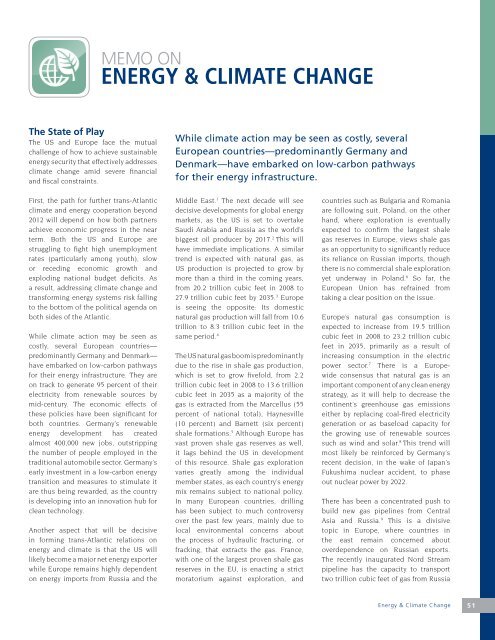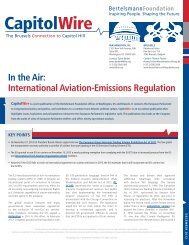BF-FieldManual-FEB13 -3.pdf - Bertelsmann Foundation
BF-FieldManual-FEB13 -3.pdf - Bertelsmann Foundation
BF-FieldManual-FEB13 -3.pdf - Bertelsmann Foundation
- No tags were found...
You also want an ePaper? Increase the reach of your titles
YUMPU automatically turns print PDFs into web optimized ePapers that Google loves.
MEMO ONENERGY & CLIMATE CHANGEThe State of PlayThe US and Europe face the mutualchallenge of how to achieve sustainableenergy security that effectively addressesclimate change amid severe financialand fiscal constraints.While climate action may be seen as costly, severalEuropean countries—predominantly Germany andDenmark—have embarked on low-carbon pathwaysfor their energy infrastructure.First, the path for further trans-Atlanticclimate and energy cooperation beyond2012 will depend on how both partnersachieve economic progress in the nearterm. Both the US and Europe arestruggling to fight high unemploymentrates (particularly among youth), slowor receding economic growth andexploding national budget deficits. Asa result, addressing climate change andtransforming energy systems risk fallingto the bottom of the political agenda onboth sides of the Atlantic.While climate action may be seen ascostly, several European countries—predominantly Germany and Denmark—have embarked on low-carbon pathwaysfor their energy infrastructure. They areon track to generate 95 percent of theirelectricity from renewable sources bymid-century. The economic effects ofthese policies have been significant forboth countries. Germany’s renewableenergy development has createdalmost 400,000 new jobs, outstrippingthe number of people employed in thetraditional automobile sector. Germany’searly investment in a low-carbon energytransition and measures to stimulate itare thus being rewarded, as the countryis developing into an innovation hub forclean technology.Another aspect that will be decisivein forming trans-Atlantic relations onenergy and climate is that the US willlikely become a major net energy exporterwhile Europe remains highly dependenton energy imports from Russia and theMiddle East. 1 The next decade will seedecisive developments for global energymarkets, as the US is set to overtakeSaudi Arabia and Russia as the world’sbiggest oil producer by 2017. 2 This willhave immediate implications. A similartrend is expected with natural gas, asUS production is projected to grow bymore than a third in the coming years,from 20.2 trillion cubic feet in 2008 to27.9 trillion cubic feet by 2035. 3 Europeis seeing the opposite: Its domesticnatural gas production will fall from 10.6trillion to 8.3 trillion cubic feet in thesame period. 4The US natural gas boom is predominantlydue to the rise in shale gas production,which is set to grow fivefold, from 2.2trillion cubic feet in 2008 to 13.6 trillioncubic feet in 2035 as a majority of thegas is extracted from the Marcellus (55percent of national total), Haynesville(10 percent) and Barnett (six percent)shale formations. 5 Although Europe hasvast proven shale gas reserves as well,it lags behind the US in developmentof this resource. Shale gas explorationvaries greatly among the individualmember states, as each country’s energymix remains subject to national policy.In many European countries, drillinghas been subject to much controversyover the past few years, mainly due tolocal environmental concerns aboutthe process of hydraulic fracturing, orfracking, that extracts the gas. France,with one of the largest proven shale gasreserves in the EU, is enacting a strictmoratorium against exploration, andcountries such as Bulgaria and Romaniaare following suit. Poland, on the otherhand, where exploration is eventuallyexpected to confirm the largest shalegas reserves in Europe, views shale gasas an opportunity to significantly reduceits reliance on Russian imports, thoughthere is no commercial shale explorationyet underway in Poland. 6 So far, theEuropean Union has refrained fromtaking a clear position on the issue.Europe’s natural gas consumption isexpected to increase from 19.5 trillioncubic feet in 2008 to 23.2 trillion cubicfeet in 2035, primarily as a result ofincreasing consumption in the electricpower sector. 7 There is a Europewideconsensus that natural gas is animportant component of any clean energystrategy, as it will help to decrease thecontinent’s greenhouse gas emissionseither by replacing coal-fired electricitygeneration or as baseload capacity forthe growing use of renewable sourcessuch as wind and solar. 8 This trend willmost likely be reinforced by Germany’srecent decision, in the wake of Japan’sFukushima nuclear accident, to phaseout nuclear power by 2022.There has been a concentrated push tobuild new gas pipelines from CentralAsia and Russia. 9 This is a divisivetopic in Europe, where countries inthe east remain concerned aboutoverdependence on Russian exports.The recently inaugurated Nord Streampipeline has the capacity to transporttwo trillion cubic feet of gas from RussiaEnergy & Climate Change5 1






